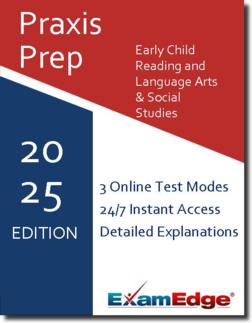Praxis Early Childhood: Reading and Language Arts & Social Studies Practice Tests & Test Prep by Exam Edge - Topics
Based on 40 Reviews
- Real Exam Simulation: Timed questions and matching content build comfort for your Praxis Early Child Reading and Language Arts & Social Studies test day.
- Instant, 24/7 Access: Web-based Praxis Early Childhood Assessment - Reading and Language Arts & Social Studies practice exams with no software needed.
- Clear Explanations: Step-by-step answers and explanations for your Praxis exam to strengthen understanding.
- Boosted Confidence: Reduces anxiety and improves test-taking skills to ace your Praxis Early Childhood Assessment - Reading and Language Arts & Social Studies (5027).

Understanding the exact breakdown of the Praxis Early Childhood Assessment - Reading and Language Arts & Social Studies test will help you know what to expect and how to most effectively prepare. The Praxis Early Childhood Assessment - Reading and Language Arts & Social Studies has 90 multiple-choice questions The exam will be broken down into the sections below:
| Praxis Early Childhood Assessment - Reading and Language Arts & Social Studies Exam Blueprint | ||
|---|---|---|
| Domain Name | % | Number of Questions |
| Reading and Language Arts | 67% | 60 |
| Emergent Literacy: Foundational Skills | ||
| Reading: Foundational Skills | ||
| Reading: Literature and Informational Text | ||
| Writing | ||
| Speaking and Listening | ||
| Language | ||
| Social Studies | 33% | 30 |
| Community, Culture, and Identity | ||
| People, Places, and Environments | ||
| Time, Continuity, and Change | ||
| Civics and Government | ||


